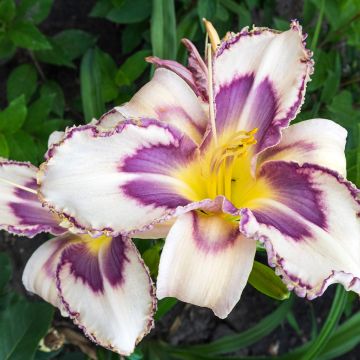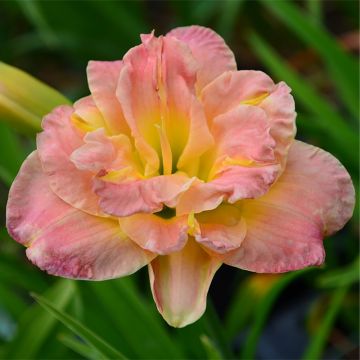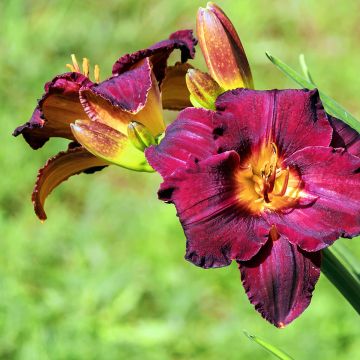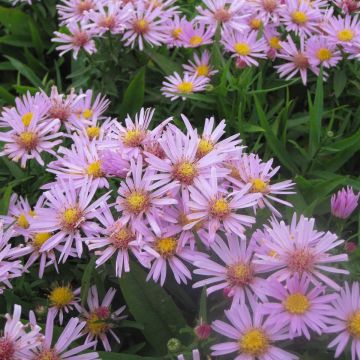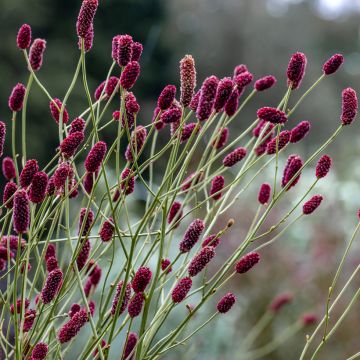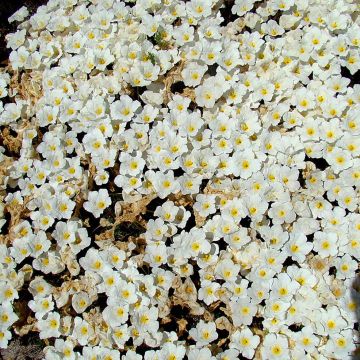

Hemerocallis middendorffii - Daylily


Hemerocallis middendorffii - Daylily


Hemerocallis middendorffii - Daylily


Hemerocallis middendorffii - Daylily


Hemerocallis middendorffii - Daylily


Hemerocallis middendorffii - Daylily


Hemerocallis middendorffii - Daylily


Hemerocallis middendorffii - Daylily
Hemerocallis middendorffii - Daylily
Hemerocallis middendorffii
Broad dwarf daylily, Middendorf's daylily, Amur daylily
This item cannot be shipped to the selected country
Delivery charge from €5.90
Delivery charge from €5.90
Delivery to Corse prohibited
More information
Schedule delivery date,
and select date in basket
This plant carries a 12 months recovery warranty
More information
We guarantee the quality of our plants for a full growing cycle, and will replace at our expense any plant that fails to recover under normal climatic and planting conditions.
From €5.90 for pickup delivery and €6.90 for home delivery
Express home delivery from €8.90.
From €5.90 for pickup delivery and €6.90 for home delivery
Express home delivery from €8.90.
Delivery to Corse prohibited: UE law prohibits the import of this plant from mainland France to Corse as part of the fight against Xylella fastidiosa. Please accept our sincere apologies.
More information

Does this plant fit my garden?
Set up your Plantfit profile →
Description
Hemerocallis middendorffii is a natural species with yellow-orange star-shaped flowers. It blooms in spring and autumn. It is a robust perennial plant that is both simple and unusual, which will thrive in moist soil, in slightly wild gardens. An interesting plant for many gardens, as it has the advantage of growing well in partial shade, making it valuable for improving a cool understory.
Hemerocallis middendorffii is a botanical daylily native to Northern China, Korea, and Japan. It forms a clump measuring 60cm (24in) tall when in bloom, with arching, stiff, linear leaves, 20 to 30cm (8 to 12in) long. In May, reddish-brown slender stalks appear, bearing wrinkled flower buds that open into golden yellow to pale orange star-shaped flowers, 6 to 8cm (2 to 3in) in diameter. It spreads at least 60cm (24in), and in ideal conditions, can cover a significant area by naturalising. It blooms from May until the end of June, and often reblooms in September. The foliage becomes dormant.
This variety enjoys both shady and sunny areas, although it does not tolerate excessively dry soil in summer. Some moisture is beneficial for it. It is not prone to diseases. It does not have the exuberance of beautiful hybrids, but it is still a satisfying plant for the garden. It is perfect for a slightly wild and rustic atmosphere. Almost indestructible once established, you will need to make room for it. You can divide the clumps at any time and share its divisions among gardeners. This daylily will look stunning planted on the edge of a water feature alongside ferns and Siberian Irises, for example. The flowers are edible: in cooking, in salads, or to accompany ice cream, they delight gourmets. A simple plant to rediscover.
Report an error about the product description
Hemerocallis middendorffii - Daylily in pictures


Flowering
Foliage
Plant habit
Botanical data
Hemerocallis
middendorffii
Hemerocallidaceae
Broad dwarf daylily, Middendorf's daylily, Amur daylily
East Asia
Other Hemerocallis - Daylilies
Planting and care
It requires little maintenance once planted. This variety is not susceptible to parasites or diseases, so there is no need to treat it and rodents are not interested in it. These plants thrive equally well in shade or sun, with 4 to 5 hours of daily sunlight being sufficient. Plant it in good garden soil that does not retain water permanently, especially in winter. Enrich your soil with a bit of compost and humus to maintain some moisture in summer. Plant by burying the neck 3 to 4cm (1 to 2in) below the surface. If planting multiple daylilies, do not place them too closely together as the space will quickly be colonised. Keep the soil moist during the first two months after planting. Some daylilies can be a bit invasive, so you can divide clumps to keep them in check. Cut back faded stems to ground level.
Planting period
Intended location
Care
-
, onOrder confirmed
Reply from on Promesse de fleurs
Summer flowering perennials
Haven't found what you were looking for?
Hardiness is the lowest winter temperature a plant can endure without suffering serious damage or even dying. However, hardiness is affected by location (a sheltered area, such as a patio), protection (winter cover) and soil type (hardiness is improved by well-drained soil).

Photo Sharing Terms & Conditions
In order to encourage gardeners to interact and share their experiences, Promesse de fleurs offers various media enabling content to be uploaded onto its Site - in particular via the ‘Photo sharing’ module.
The User agrees to refrain from:
- Posting any content that is illegal, prejudicial, insulting, racist, inciteful to hatred, revisionist, contrary to public decency, that infringes on privacy or on the privacy rights of third parties, in particular the publicity rights of persons and goods, intellectual property rights, or the right to privacy.
- Submitting content on behalf of a third party;
- Impersonate the identity of a third party and/or publish any personal information about a third party;
In general, the User undertakes to refrain from any unethical behaviour.
All Content (in particular text, comments, files, images, photos, videos, creative works, etc.), which may be subject to property or intellectual property rights, image or other private rights, shall remain the property of the User, subject to the limited rights granted by the terms of the licence granted by Promesse de fleurs as stated below. Users are at liberty to publish or not to publish such Content on the Site, notably via the ‘Photo Sharing’ facility, and accept that this Content shall be made public and freely accessible, notably on the Internet.
Users further acknowledge, undertake to have ,and guarantee that they hold all necessary rights and permissions to publish such material on the Site, in particular with regard to the legislation in force pertaining to any privacy, property, intellectual property, image, or contractual rights, or rights of any other nature. By publishing such Content on the Site, Users acknowledge accepting full liability as publishers of the Content within the meaning of the law, and grant Promesse de fleurs, free of charge, an inclusive, worldwide licence for the said Content for the entire duration of its publication, including all reproduction, representation, up/downloading, displaying, performing, transmission, and storage rights.
Users also grant permission for their name to be linked to the Content and accept that this link may not always be made available.
By engaging in posting material, Users consent to their Content becoming automatically accessible on the Internet, in particular on other sites and/or blogs and/or web pages of the Promesse de fleurs site, including in particular social pages and the Promesse de fleurs catalogue.
Users may secure the removal of entrusted content free of charge by issuing a simple request via our contact form.
The flowering period indicated on our website applies to countries and regions located in USDA zone 8 (France, the United Kingdom, Ireland, the Netherlands, etc.)
It will vary according to where you live:
- In zones 9 to 10 (Italy, Spain, Greece, etc.), flowering will occur about 2 to 4 weeks earlier.
- In zones 6 to 7 (Germany, Poland, Slovenia, and lower mountainous regions), flowering will be delayed by 2 to 3 weeks.
- In zone 5 (Central Europe, Scandinavia), blooming will be delayed by 3 to 5 weeks.
In temperate climates, pruning of spring-flowering shrubs (forsythia, spireas, etc.) should be done just after flowering.
Pruning of summer-flowering shrubs (Indian Lilac, Perovskia, etc.) can be done in winter or spring.
In cold regions as well as with frost-sensitive plants, avoid pruning too early when severe frosts may still occur.
The planting period indicated on our website applies to countries and regions located in USDA zone 8 (France, United Kingdom, Ireland, Netherlands).
It will vary according to where you live:
- In Mediterranean zones (Marseille, Madrid, Milan, etc.), autumn and winter are the best planting periods.
- In continental zones (Strasbourg, Munich, Vienna, etc.), delay planting by 2 to 3 weeks in spring and bring it forward by 2 to 4 weeks in autumn.
- In mountainous regions (the Alps, Pyrenees, Carpathians, etc.), it is best to plant in late spring (May-June) or late summer (August-September).
The harvesting period indicated on our website applies to countries and regions in USDA zone 8 (France, England, Ireland, the Netherlands).
In colder areas (Scandinavia, Poland, Austria...) fruit and vegetable harvests are likely to be delayed by 3-4 weeks.
In warmer areas (Italy, Spain, Greece, etc.), harvesting will probably take place earlier, depending on weather conditions.
The sowing periods indicated on our website apply to countries and regions within USDA Zone 8 (France, UK, Ireland, Netherlands).
In colder areas (Scandinavia, Poland, Austria...), delay any outdoor sowing by 3-4 weeks, or sow under glass.
In warmer climes (Italy, Spain, Greece, etc.), bring outdoor sowing forward by a few weeks.

































